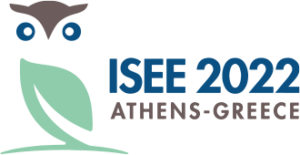 The 34th Annual ISEE Conference will take place in-person in Athens, Greece from September 18-21, 2022, which will be the first in-person Conference after two years of fully online Conferences (2020, 2021). The Conference will also have a hybrid format.
The 34th Annual ISEE Conference will take place in-person in Athens, Greece from September 18-21, 2022, which will be the first in-person Conference after two years of fully online Conferences (2020, 2021). The Conference will also have a hybrid format.
The main theme of the 2022 Conference is Strengthening the global role of environmental epidemiology, stressing the need to study and understand local conditions in order to synthesize the knowledge and make a difference for our planet.
Dr. Angie Cradock will present virtually on Monday, September 19 from 1:15 – 2:45 PM along with several others about safe home water access for low-income families with young children, as part of a larger session, “Disparities in US drinking water quality and access.”
Session Title: Safe home water access for low-income families with young children
Date & Time: Monday, September 1, 1:15 – 2:45 PM
Part of:
PROPOSAL ABSTRACT (#25)
Title: Disparities in US drinking water quality and access
Chairs: Ronnie Levin1, Jacqueline Gibson2
Presenters: Angie Cradock1, Darya Minovi3, Erik Olson4, Laurel Schaider5
1Harvard School Of Public Health, Newton, United States of America, 2Department of Environmental and Occupational Health, Indiana University, Bloomington, USA, 3Center for Progressive Reform, Washington, USA, 4Natural Resources Defense Council, Washington, USA, 5Silent Spring Institute, Newton, USA
As analytical methods and social consciousness have evolved, so too has our awareness of social disparities and inequities related to environmental benefits and burdens. Mounting research and data reveals inconsistent environmental compliance by the United States’ 60,000 community water systems. Contamination of drinking water with lead, nitrates and industrial chemicals is not distributed equally: low-income, immigrant, Indigenous, and communities of color have higher exposures to hazardous drinking water contamination. At the same time, data show that many low-income families in both urban and rural areas do not have access to safe drinking water at home, compounding the toll particularly from the COVID-19 pandemic. Socioeconomic disparities are evident in exposures to industrial contaminants in US EPA’s unregulated drinking-water monitoring data. Flint Michigan is the most widely publicized municipal water crisis, but more typical than extreme: in 2015, an estimated 18 million Americans received water with high lead levels. Investigations of nitrate contamination show increasing levels associated with expanded agricultural activities, concentrated animal feedlots and land development. Nitrate contamination is more frequent in rural, low-income, minority and immigrant communities.
These disparities can no longer be ignored. In this symposium, we will highlight some of the current and emerging data on lead exposures associated with US public and private water supplies, disparities in access to clean drinking water for low-income families with young children, and systemic policy and implementation factors that maintain these inequities.